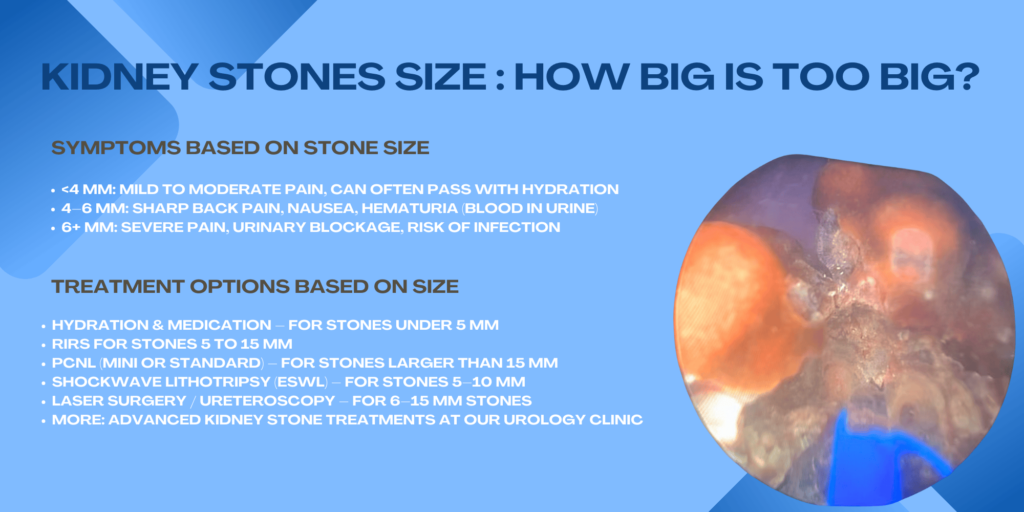Kidney stones are a common urological condition affecting millions of people each year. Many stones pass on their own. However, the size of the kidney stone is critical in determining whether medical or surgical intervention is necessary.
Kidney stones can occur due to a variety of factors, including diet, genetics, and underlying medical conditions. Understanding these factors can help individuals take preventive measures. For instance, excessive intake of sodium can lead to increased calcium in urine, raising the risk of stone formation. Likewise, dehydration can concentrate urine and promote stone development. It is essential to maintain a balanced diet and stay hydrated to minimize the risk.
Moreover, the impact of kidney stones extends beyond physical symptoms; they can also affect mental health. Individuals experiencing recurrent kidney stones may develop anxiety or fear surrounding their health. Support groups and counseling can play a vital role in helping individuals cope with the psychological toll of kidney stones.
In this post, we’ll explore how stone size affects symptoms, treatment options, and when it’s time to consult a urologist.
🔍 Different Types of Kidney Stones
📚 Furthermore, kidney stones can vary in color, shape, and composition. This diversity can sometimes provide clues about their origin. For example, calcium stones are typically yellow or brown, while uric acid stones are often red or orange. Identifying these characteristics can be useful for urologists when determining the best course of action for treatment.
Kidney stones can be categorized into several types, each with distinct causes and characteristics. The most common types include calcium stones, which are primarily formed from calcium oxalate or calcium phosphate; struvite stones, which often develop in response to urinary tract infections; uric acid stones, which are linked to diets high in purines; and cystine stones, which are rare and result from a genetic disorder. Knowing the type of stone can influence treatment and prevention strategies.
🧊 What Are Kidney Stones?
💧 Additionally, lifestyle modifications can significantly impact kidney stone formation. Increasing fluid intake is one of the most effective strategies, as it helps dilute substances in urine that lead to stones. Moreover, dietary adjustments, such as reducing oxalate-rich foods, can contribute to prevention. Foods like beets, peanuts, and chocolate are high in oxalates and should be consumed in moderation by individuals prone to kidney stones.
Kidney stones are hard deposits made of minerals and salts that form inside your kidneys. They vary in size. They can range from a grain of sand to a large pebble. They can cause intense pain when passing through the urinary tract.
🏥 When experiencing kidney stone symptoms, seeking prompt medical attention can help prevent complications. Urologists may recommend imaging tests, such as ultrasounds or CT scans, to confirm the presence and size of stones. Early detection can lead to timely intervention, which is crucial for avoiding severe pain and potential kidney damage.
📖 Learn more: Symptoms of Kidney Stones — When to See a Urologist
📏 Stone Size Guide: When Is It Too Big?
🚑 In cases where stones cause significant blockage, immediate treatment may involve procedures to relieve pressure on the kidneys. This could include placing a stent to facilitate urine flow or performing nephrostomy to drain urine directly from the kidney.
| Stone Size | Likely Outcome |
|---|---|
| Less than 4 mm | May pass naturally in 90% of cases |
| 4–6 mm | 50% chance of passing without treatment |
| 6–10 mm | Unlikely to pass without medical help |
| Larger than 10 mm | Almost always requires surgical removal |
A kidney stone over 6 mm often causes severe symptoms. It can also lead to blockage. Stones larger than 10 mm typically require procedures like ureteroscopy, laser lithotripsy, RIRS (Retrograde Intra-renal Surgery or PCNL (percutaneous nephrolithotomy).
🚨 Symptoms Based on Stone Size
- <4 mm: Mild to moderate pain, can often pass with hydration
- 4–6 mm: Sharp back pain, nausea, hematuria (blood in urine)
- 6+ mm: Severe pain, urinary blockage, risk of infection
If you’re experiencing persistent pain, fever, or vomiting, it’s time to visit a urologist immediately.
✅ Need a urologist? Book an appointment with Dr. Saurabh Mishra – Urology Expert in Delhi
💊 It’s essential to discuss medication options with your healthcare provider. Certain medications can help manage pain or address the underlying conditions contributing to stone formation. For example, thiazide diuretics can decrease calcium levels in urine, while potassium citrate can help prevent calcium and uric acid stones.
🛠️ Treatment Options Based on Size
- Hydration & Medication – for stones under 5 mm
- PCNL (Mini or Standard) – for stones larger than 15 mm
- Shockwave Lithotripsy (ESWL) – for stones 5–10 mm
- Laser Surgery / Ureteroscopy /RIRS– for 6–15 mm stones
💡 Tips to Prevent Kidney Stones
- Drink at least 2.5–3 liters of water daily
- Limit salt, animal protein, and oxalate-rich foods (like spinach)
- Take prescribed medication for recurrent stones
- Regularly monitor your urinary health
🌟 In conclusion, understanding the intricacies of kidney stones can empower individuals to take proactive measures. With proper knowledge about stone types, sizes, and prevention strategies, many may avoid the discomfort and complications associated with kidney stones. Continuous research into treatment options and preventive measures remains vital in improving patient outcomes.
🧬 Conclusion: Know Your Stone, Know Your Options
The size of your kidney stone matters—a lot. While small stones might pass naturally, larger stones often require expert intervention. Ignoring symptoms or delaying treatment can lead to complications like infection, kidney damage, or emergency surgery.
👉 If you’re unsure about the size or treatment needed for your stone, don’t wait.
📞 Contact Dr. Saurabh Mishra today for expert evaluation and care.
📈 Finally, adopting a proactive stance towards kidney health, including regular check-ups and consultations with a urologist, can make a significant difference. This approach not only aids in early detection but also fosters overall well-being.




